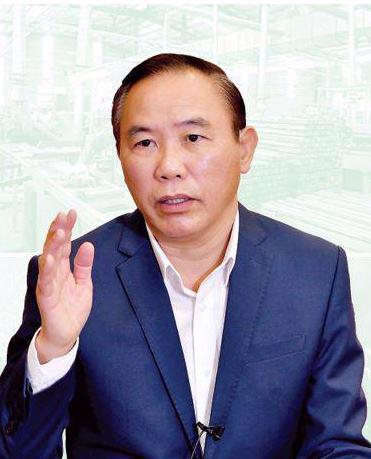The Ministry of Agriculture and Environment (MAE) has entered its first working week after being formed by a merger between the Ministry of Agriculture and Rural Development (MARD) and the Ministry of Natural Resources and Environment (MoNRE). Can you tell us about its operations post-merger?
We have not faced any obstacles from the merger. Though the merger of MARD and MoNRE was carried out rapidly, no tasks were overlooked, no disruptions occurred, and all operational processes have been ensured.
The delegation of responsibilities to ministry leaders remains clear, with each Deputy Minister directly overseeing their respective sectors. During the merger process, both former ministries held separate meetings, followed by multiple bilateral working sessions to consolidate efforts and finalize outstanding documents, ensuring a smooth transition under the new entity - the Ministry of Agriculture and Environment.
MoNRE had a Digital Transformation Center and MARD had an Agricultural Statistics and Digital Transformation Center, which collaborated to enable the completion of all pending administrative procedures by February 28 and the transition to a new official seal for all documents.
Pursuing the government resolution on cutting administrative procedures is also a crucial task, acting as a key driver for the sector’s growth and export performance. In these initial working days, no bottlenecks have appeared, particularly in administrative procedures. All sectoral activities continue without disruption, ensuring seamless operations while maintaining full coverage of industries, facilities, and businesses.
How do you view agricultural, forestry, and fisheries exports in the first two months of 2025?
The export value of products reached $9.38 billion, an 8.3 per cent increase compared to the same period of 2024. Agricultural exports reached $4.89 billion, up 4.5 per cent, with livestock product exports at $72.2 million, up 4 per cent; fisheries exports stood at $1.42 billion, up 18.6 per cent; forestry exports totaled $2.68 billion, up 11.9 per cent; production input exports amounted to $307.6 million, down 0.2 per cent; and salt exports reached $1.4 million, doubling year-on-year.
Most major sectors continued to grow and maintained a trade surplus. Notably, coffee exports saw a significant 26.2 per cent increase in value despite a 28.2 per cent decline in volume, with projections suggesting coffee exports could reach $6 billion in 2025. Seafood exports recorded $1.42 billion in value in the first two months, up 18.6 per cent year-on-year. Similarly, wood and wooden product exports reached $2.52 billion, marking a 12.4 per cent increase compared to the same period of 2024.
However, fruit and vegetable exports declined 11 per cent, while rice exports saw a 13.6 per cent fall in value compared to the first two months of 2024. The sector must therefore continue to capitalize on its strengths while addressing the challenges faced by declining product categories such as fruit and rice through targeted solutions to enhance value in the months ahead.
Given those results, what new challenges lie ahead for agricultural, forestry, and fisheries exports?
The sector’s exports play a crucial role in Vietnam’s economy as they generate real revenue and trade surpluses, providing foreign exchange to drive the country’s industrialization and modernization. At a government meeting in January, the looming trade war was highlighted as a key concern, especially following US President Donald Trump’s first two months in office, which have had a significant impact on global markets. In reality, fluctuations were already observed in the Chinese market and several other countries.
At the same time, developments in US-Europe relations with Ukraine remain highly volatile and could have ripple effects on our economy. However, we assess that the impact on Vietnam’s agricultural exports will not be overly significant. Facing these challenges, we must analyze and implement appropriate solutions to achieve the government’s export target of $65 billion and potentially strive for $70 billion if conditions are favorable.
It is essential to leverage products with comparative advantages while identifying and addressing difficulties in specific sectors. For example, Vietnam exported 9.15 million tons of rice in 2024, and we expect to maintain exports at around 9 million tons this year. We are also accelerating the transition to high-quality rice varieties, aiming for fragrant rice and specialty rice to account for 75 per cent of total exports in 2025. This strategic shift ensures that any decline in rice export volumes will be minimal, as we target higher-value markets that demand premium-quality products, thereby maintaining both export volume and value.
How do you view the growth potential of the agriculture sector in 2025?
The government has set a target of 4 per cent growth for this year. A closer look at each sub-sector reveals that crop production contributes 43 per cent to total agricultural value, with peak growth reaching 2.2 per cent in some years but generally ranging between 1.5 and 1.8 per cent.
Livestock, which accounts for 26 per cent of agricultural GDP, recorded its highest growth, of 5.92 per cent, in 2022. Meanwhile, the fisheries sector, contributing 28 per cent to agricultural GDP, has maintained an annual growth rate of 3.5 to 3.8 per cent. The forestry sector, though smaller in proportion, consistently grows at around 7 per cent annually. These figures highlight the key areas where we must implement strategic growth measures to ensure the sector meets its 4 per cent target.
Given the ongoing global uncertainties, the MAE has been closely monitoring developments and implementing targeted solutions to maintain agricultural export turnover in 2025. Achieving the 4 per cent growth target set by the government requires a comprehensive review and strategic restructuring of each industry within the sector, to ensure sustainable progress.
In terms of exports, Vietnam’s agricultural sector still has substantial untapped potential. The most critical driver for future growth is science and technology, which will play a decisive role in elevating Vietnam’s position in global agriculture. Resolution No. 57-NQ/TW provides a strategic framework for advancing science, technology, innovation, and national digital transformation, and must be fully leveraged.
Our first priority is to accelerate the application of cutting-edge science and technology in a more robust and effective manner. Since over half of the sector’s added value comes from technological advancements, we need to focus on seed development, modern cultivation techniques, plant protection, veterinary medicine, and other critical areas. These improvements must align with circular economy principles and digital transformation initiatives, ensuring transparency and traceability to enhance Vietnam’s competitiveness in global markets.
Another key growth avenue lies in deep processing, which presents immense opportunities for value creation. Currently, a significant portion of Vietnam’s agricultural exports remains in bulk, unbranded formats rather than high-value processed products. This underscores the need to enhance processing capabilities to meet global standards. As agricultural land expansion is no longer an option, the focus must shift towards increasing productivity, improving product quality, and developing raw material zones that support advanced processing. Strengthening deep processing will not only boost export value in 2025 but also lay the foundation for sustainable growth in the 2026-2030 period.









 Google translate
Google translate